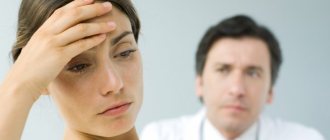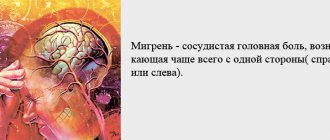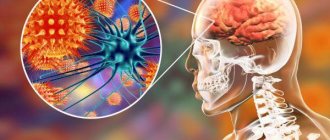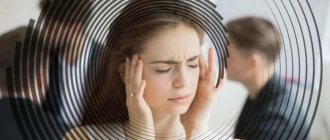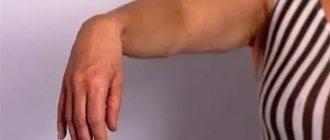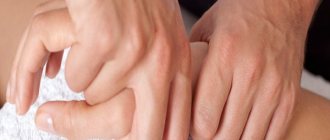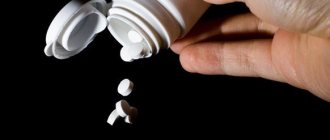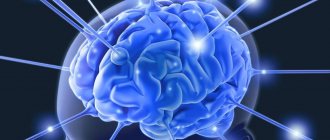There are about 200 known causes of headaches (cephalalgia). This may be an increase or decrease in blood pressure, pathology of cerebral vessels, diseases of the spine, brain vessels, brain tumors, intoxication. At the Yusupov Hospital, neurologists find out the cause of headaches using the latest diagnostic equipment from the world's leading manufacturers.
Headaches in the forehead can bother a patient with sinusitis or frontal sinusitis. In this case, treatment is carried out by otolaryngologists. If the cause of the headache is arterial hypertension, cardiologists provide antihypertensive therapy. In the presence of intoxication, infectious disease specialists treat patients with headaches. A multidisciplinary approach to the treatment of patients suffering from headaches can quickly improve the patient's condition.
Causes of headaches in women
When developing tactics for managing a patient with headache, neurologists at the Yusupov Hospital take into account its cause. Doctors relieve headaches with analgesics and at the same time treat the disease that caused this syndrome. Most often, headaches in women occur for the following reasons:
- Hormonal imbalances;
- Acute or chronic stress;
- Increase or decrease in blood pressure;
- Dysfunction of the autonomic nervous system;
- Diabetes mellitus;
- Infectious diseases (meningitis, encephalitis, tuberculosis);
- Inflammation of the neck muscles:
- Osteochondrosis of the cervical spine;
- Volumetric formations of the brain.
Causes of headaches in men
Men are most often bothered by cluster pain. It is localized in the temple area and the eyeball. Pain of varying intensity in men occurs during a respiratory disease, an infectious lesion of the body, after an injury, or during the development of a brain tumor. Headaches localized in the back of the head occur with arterial hypertension, stroke, and traumatic brain injury. Often men experience severe headaches accompanied by nosebleeds. The reasons for the violation may be:
- Diseases of the circulatory system;
- Failure of endocrine organs;
- Cardiovascular diseases;
- Meningitis.
- Stroke;
- Tumors of the brain or nasal cavity;
- Hypertension;
- Overwork.
Expert opinion
Author:
Tatyana Aleksandrovna Kosova
Head of the Department of Rehabilitation Medicine, neurologist, reflexologist
90% of the population has experienced headache symptoms at least once in their life. Such data is provided by the World Health Organization. In 20% of cases, the headache is permanent. The ratio in the morbidity structure among men and women is 1:3. Neurologists identify various causes of headaches. The most common etiological factors are migraine and tension headache. Migraine is diagnosed in 20–30% of cases, and tension headaches account for 50–70%.
A headache can be a symptom of a serious illness. Therefore, if a pathological sign appears frequently, as well as in the presence of other symptoms, you should consult a doctor. At the Yusupov Hospital, neurologists pay close attention to the treatment of various types of headaches. Diagnosis of possible causes is carried out using x-rays, MRI, CT, EEG, angiography and laboratory tests. If necessary, additional studies are prescribed. Individually selected therapy allows you to stop an acute attack and prevent the re-development of the pathological symptom. The drugs used are verified for quality and safety. Treatment regimens comply with international recommendations for headache therapy.
Causes
Constant pain in the head can indicate more than just illness. In some cases, there is prolonged exposure to the provoking factor, which is accompanied by a similar symptom. Among them:
- frequent changes in weather conditions (such people are called weather dependent);
- violation of the work and rest schedule;
- systematic or chronic stress;
- eating disorder, overeating;
- prolonged exposure to conditions with hot or, conversely, cold air;
- physical exercise;
- abuse of smoking or alcoholic beverages.
If the above provoking factors are absent, the cause of persistent headaches may be a disease, for example, migraine. In this case, the discomfort is acute and pulsating in nature, complemented by an increase in general temperature and vomiting. If vomiting syndrome is present, you should urgently call a doctor.
Vascular diseases occur with the main clinical manifestation – headaches. This applies to vegetative-vascular dystonia, hypertension, transient ischemic attacks, subarachnoid hemorrhage, intracerebral hematomas, vascular malformation, arteritis and stroke.
Vegetative-vascular dystonia occurs with headaches, impaired consciousness, increased or decreased blood pressure, neurological disorders, and nausea. Exacerbation of symptoms occurs with changes in climatic conditions, nervous strain and disorders.
Hypertension, that is, high blood pressure, is characterized by pain in the head, as well as symptoms such as tinnitus, goosebumps before the eyes, nausea, and chest discomfort. A persistent headache until the end of the attack is localized in the occipital region.
With venous dysfunction, headache occurs in the morning and evening. In combination, a person feels heaviness and pressure in the head - symptoms that are bilateral in nature.
If the symptom bothers you frequently and has a pulsating nature, this may indicate an impending stroke. The main attack is characterized by severe pain, which is complemented by dizziness and impaired consciousness.
Constant severe headaches also indicate temporal arteritis. The discomfort is located in the temple area.
With an infectious lesion of the brain, for example, encephalitis or a consequence of a cold, the body temperature rises, heaviness and pain in the head occur, pressure is felt in the eyes and ears, and nausea and vomiting syndrome is present.
What a constant headache indicates can only be determined by a doctor, since in addition to diseases occurring in the brain, the symptom also occurs against the background of eye pathologies, for example, glaucoma, strabismus, and refractive error. In such cases, the discomfort is aching in nature, and heaviness appears in the eyes.
Ear diseases and pathological processes occurring in the nasal and oral cavities are often to blame. A person is bothered by headaches, and their localization is associated with the area of inflammatory reaction.
With cranial neuralgia, the attack is severe and cutting in nature. Pain occurs when talking, chewing food, or drinking cold water. After eliminating the action of the provoking factor, the symptoms disappear.
Headaches from the back, from the back of the head to the cervical region, are a symptom of a disease of the spinal column in the neck area. These are degenerative-dystrophic changes, the development of discogenic radicular syndrome, and vertebral instability. The nature of the discomfort is dull and prolonged. The severity of the symptom increases when turning the head or tilting.
With the development of an oncological process, renal failure, or diabetes, pain in the head indicates a metabolic imbalance.
There is another, not common, cause of persistent headache - a history of puncture of the dura mater for diagnostic or therapeutic purposes. This also includes epidural anesthesia, in which headache is a complication.
The symptom is caused by the leakage of cerebrospinal fluid through the hole for puncturing the skin, a decrease in its volume in the area of the brain and spinal cord. The presence of post-puncture headache is observed for 2 or more days after a diagnostic or therapeutic event. Discomfort is relieved after taking a lying position.
Kinds
Neurologists distinguish the following types of headaches:
- Migraine – caused by a disruption of the vascular system;
- Tension headache - mainly occurs due to excessive tension in the neck, eye muscles, as well as the muscles of the shoulder girdle and scalp aponeurosis, as well as due to chronic stress, depression;
- Chronic paroxysmal hemicrania, cluster headache - can be primary or secondary.
- Headache not associated with damage to brain structures;
- Ambus headache that occurs when taking medications uncontrolled.
There are also headaches after traumatic brain injury, with diseases of the vascular system, and those that occur with intracranial disorders of extravascular origin.
Tensor headaches often occur in women after stress or nervous shock. It goes away in the presence of positive emotions, after drinking soothing herbal teas.
Neurologists do not recommend taking headache pills on your own. Each drug is designed to relieve a specific type of pain and has a number of contraindications. The doctor takes all this into account when prescribing a medicine to a patient.
Make an appointment
Use essential oils
Essential oils are obtained from various plants. They are a liquid with a high concentration of active aromatic compounds. Due to their various medicinal properties, oils are used topically, some of them are suitable for internal use.
In the fight against headaches, essential oils of mint and lavender give good results. They are especially important for patients for whom traditional medications are contraindicated, such as pregnant women. Symptoms of tension headaches are relieved by rubbing peppermint oil into the temples. Lavender is an effective remedy for migraine attacks. It is applied to the upper lip or inhaled. [6]
If you create a mixture of essential oils, they will complement each other in properties. Let's give specific examples. Use cold compresses. They are placed in several places:
- Forehead.
- Whiskey.
- Neck.
- Back of the head.
Dissolve 4-6 drops of special essential oil in 100 ml of water. It is made up of 4-6 drops of lavender oil, or a few drops of lavender and the same amount of peppermint, or 3 drops of lavender, 2 of chamomile, 1 of lemon.
Also soak a scarf with a few drops of lavender and inhale the aroma for several minutes. And 2 drops of lemon oil can be rubbed into the temples and other specified areas if a migraine begins.
Peppermint oil has been used for headaches since ancient times. This method was already known in Ancient Greece. Buy an aroma lamp and add the following mixture to it. 2 drops lemon, 2 chamomile, 1 peppermint, 1 drop marjoram oil, 2 drops lavender.
If you have a bottle of smelling salts, prepare another mixture. To 1 drop of peppermint add 5 - lavender, 1 drop - lemon, 1 - nutmeg essential oil, 4 ml of sunflower oil. If headaches bother you often, a mixture of 3 types is rubbed into the area of the temples, forehead and back of the head. The composition is created from 0.5 liters of ordinary water, 3 drops of mint essential oil, 3 drops of lavender and 3 drops of wormwood essential oil.
Bath lovers can also pamper themselves while fighting headaches. A composition of orange, geranium and mint in a ratio of 2:4:4 helps.
Migraine
Migraine is the most common type of headache.
It most often occurs in women from the onset of puberty (from 11-13 years) to 35 years. Migraine can be simple or with an aura. It can occur in the temple, crown, back of the head, and forehead. The cause of the disease is a hereditary disorder of vasomotor regulation of arteries located outside and inside the cranium. With migraines, headaches occur in the form of attacks. They bother you at varying frequencies - from once a week to once a year. The attack lasts from several hours to 3 days. Usually the pain is throbbing and covers half of the head. It often occurs after physical activity, stress, lack of sleep or too much sleep, or eating certain foods. A migraine attack is accompanied by nausea and vomiting, intolerance to bright light, noise, and strong odors. Sometimes the headache is very severe and lasts for several days - this condition is called status migraine. According to statistics, migraine occurs in 2% of people.
Neurologists believe that a migraine attack develops under the influence of the following provoking factors:
- Chronic stress;
- Overwork;
- Intense mental work;
- Hormonal disorders.
Often the cause of migraine is a family history.
Tension headache
This type of headache occurs as a result of prolonged tension in the muscles of the head and neck.
Tension headaches can be chronic and bother you constantly, only sometimes stopping for 2-3 days. There are no other violations. There is no nausea or vomiting, bright lights and loud noise do not cause suffering. Almost all sick people lead a normal life and have normal performance. Tension headaches often affect people with increased anxiety and a tendency to become depressed. Pain often occurs against the background of severe stress. There is a feeling of pressure on the top of the head or compression of the entire head. Many people suffering from this disorder take a lot of painkillers on a regular basis. Over time, this “treatment” can itself lead to headaches. Tension headaches are treated with antidepressants - only a doctor can prescribe them. Head massage and acupuncture help improve the condition.
In the eye and forehead area
Headaches in the forehead area are caused by various factors.
Cluster or beam pain occurs in the eye area. She may return after a while. Sometimes attacks continue for several hours. A headache that radiates to the eyeball can be a sign of migraine, eye diseases, brain tumors, and neurological diseases of the brain. It often occurs after severe or prolonged stress. The cause of the headache may be inflammation of the maxillary or frontal sinuses. It often radiates into the eyeballs. Sinus headache disappears after the underlying disease is cured. Pain in the forehead is a common symptom of meningitis, malaria, typhoid, and pneumonia.
In the occipital region of the head
In the back of the head, cephalgia occurs when blood pressure increases, the cause of which is osteochondrosis, spondylosis, spondylolisthesis, anomalies in the development of blood vessels in the head or neck.
Severe pain in the back of the head occurs after nervous strain, as a result of spasm of the neck muscles, arteries of the head and neck, and disruption of the outflow of venous blood from the head. It worries patients suffering from occipital neuralgia, vertebrobasilar insufficiency, spinal diseases, and migraines. A sharp headache in the back of the head often occurs with the development of a hypertensive crisis. Sharp, bursting, pulsating headaches in the back of the head are accompanied by pallor of the patient’s face, generalized hyperhidrosis, dry mouth, heart pain and tachycardia.
Chronic arterial hypertension with a slight increase in blood pressure is also characterized by the development of pain mainly in the occipital part of the head. The headache bothers the patient immediately after waking up, intensifies with physical activity, and is often accompanied by swelling of the lower eyelids. Pain is caused by a violation of the outflow of venous blood from the vessels of the head.
Combined with nausea
Severe headache and nausea are signs of migraine, meningitis, and hypertensive crisis.
Often the cause of these symptoms is sinusitis, sinusitis, or intoxication of the body. Nausea, headache, and dizziness are also symptoms of traumatic brain injury and infectious diseases. Patients complain of headache, nausea, weakness at the initial stage of influenza and acute respiratory infection. In this case, the body temperature rises to high numbers. The development of a migraine can be signaled by ripples in the eyes, nausea and headache. With a migraine, the patient's appetite disappears, an aversion to strong odors appears, nausea, irritability, photophobia, and numbness in certain parts of the body occur.
Headache and dizziness also occur when wearing incorrectly selected glasses or lenses or disruption of the vascular system. Headaches and spots in the eyes appear due to fatigue and nervous exhaustion, during weather changes, after stress. These symptoms occur in people who have suffered a traumatic brain injury, spinal injury or disease.
Headache and flashing spots before the eyes appear during a hypertensive crisis. Its variety - hyperkinetic crisis - begins abruptly with headache, nausea, flickering of spots before the eyes and vomiting. The patient feels hot. His sweating and heart rate increase. Trembling is felt throughout the whole body. High blood pressure can cause hypertensive encephalopathy. It manifests itself with the following symptoms:
- Very severe headache;
- Dizziness;
- Nausea;
- Vomiting;
- The flickering of flies in the eyes.
The patient may lose consciousness and die if medical care is not provided in a timely manner.
Headaches that occur in the morning after sleep can be a manifestation of a brain tumor, abusive cephalalgia, tension pain, or migraine. Overuse headache occurs with long-term use of analgesics. It gets worse in the morning. The intensity of the pain constantly changes throughout the day. Overuse headaches are aggravated by stress, mental tension, excessive physical activity, and also by stopping a drug that relieves pain. Abuse cephalgia becomes permanent if the patient suffers from depressive syndrome, is often irritated, and is very tired. Due to constant headaches, a person’s concentration and performance decrease. He sleeps poorly and constantly feels tired.
See a doctor urgently
In some situations, you should not postpone a visit to a specialist, since the patient requires urgent medical attention. Medical attention is needed if:
- Head pain occurs suddenly and is of high intensity. This symptom may indicate a cerebral aneurysm. This pathology is life-threatening for the patient and therefore requires urgent surgical intervention.
- The headache constantly hurts, and each time the intensity of the pain syndrome increases. This may indicate a developing tumor in the head.
- Against the background of cephalgia, numbness appears in the limbs and vision is impaired.
- Headache and shortness of breath appear, body temperature rises. Among the causes may be a common sore throat, or serious pathologies of the heart muscle.
- Frequent headaches are observed in older people. They can be a signal of the development of trigeminal neuralgia, temporal arteritis or other serious disorders.
- A headache appears after a fall or head injury and is accompanied by speech impairment, confusion, numbness in the arms or legs.
- The painful syndrome does not become less intense, despite taking analgesics.
- Debilitating pain occurs every day.
- The child is worried about a headache that appeared for the first time and does not go away for a long time.
- Each time the intensity of the headaches becomes greater, and they bother you more and more often.
- The headache is accompanied by soreness in the eyes, nose or ears.
- Severe attacks due to hormonal imbalances.
If any headache is accompanied by vomiting, convulsions or loss of consciousness, you should immediately call a doctor.
Temporal headache
Severe headaches in the temples bother patients with otitis media and migraines.
It occurs when intracranial and blood pressure increases. One of the causes of pain in the temple area is inflammation or injury to the temporomandibular joint. In this case, pain occurs in the temple area and radiates to the ear and eye. Sometimes painful sensations occur in the shoulder, neck, and shoulder blade. If the temporomandibular joint is not positioned correctly, muscle spasm develops, which causes increased headaches. After treatment of the underlying disease, the pain goes away. One of the causes of headaches in the temple area is arteritis. This is a disease in which the inflammatory process affects the vessels of the head and temporal region. Due to autoimmune inflammation of the walls of arteries and large vessels in the temporal region, immune complexes are deposited on their walls, which are produced in response to infection. The immune system perceives these cells as foreign. The walls of the blood vessels thicken and blood clots form on them. This pathology is manifested by severe headache in the temple area, general weakness, and impaired visual function. As the disease progresses, arterial damage leads to organ failure.
A common cause of pain in the temple, in the eye area and severe pressing pain in the skull is stress. With deterioration of memory, hearing, vision and constant throbbing severe pain in the temple area, a neurologist may suspect the development of a brain tumor.
Sharp pain in the temple area is a common symptom of a stroke. It is accompanied by numbness on one side of the face, body, and loss of speech. Hemorrhagic stroke can occur due to a rupture of a cerebral artery aneurysm. Acute vascular accident develops as a result of stress. Its harbinger can be a severe headache.
Drink caffeinated coffee or tea
Leisurely sipping coffee or tea helps with headaches. Caffeine has a positive effect on the emotional background, gives a feeling of cheerfulness, and constricts blood vessels. All these qualities have a positive effect on a person’s condition during a headache attack. [10]
What is the effectiveness of this publicly available remedy? Tea contains substances that stimulate the central nervous system. The effect is mild compared to coffee. More oxygen flows to the brain. As a result, the patient feels calm and has a relaxing effect. The blood vessels stop suffering from spasms. The blood circulation process improves and normalizes, bringing relief. Often a headache occurs when there is a lack of oxygen in the blood cells, and when this deficiency is replenished, everything returns to normal.
Those who have the habit of drinking a cup of real coffee in the morning know what effect you can get. This substance is contained in special capsules; they are taken in medicine to combat migraines, as well as if it is necessary to increase physiological or mental tone.
Caffeine is found in many headache medications. Among them are Caffetin, Panadol, Pentalgin-N, Citramon. There are more than 50 items in total. If an attack develops, it is better not to drink cups of coffee, but to choose tea, which, by the way, also contains caffeine, and take medicine.
Caffeine can enhance the effect of some medications used to relieve headaches, for example, ibuprofen, acetaminophen. It should be said that giving up coffee after long-term regular use can also cause headaches.
Green tea for headaches
should be taken at the first symptoms of an attack. It is prepared slightly differently than black. To feel the result, add a pinch of mint to the cup.
This is an excellent remedy for many headaches that cause overwork, fatigue, PMS, and vascular spasms in the brain system. As a preventative measure, drink it with a small amount of honey at least once a day on an empty stomach. The effect is similar to black tea.
The recipe is very accessible. Green tea is brewed in a clean porcelain teapot, then it is poured into a cup and a little honey is added. No need to overdo it with additives. Note that green tea reduces blood pressure; it is dangerous to drink it in one gulp.
More details:
Table of caffeine content - in different brands of green and black tea
Headache and tinnitus
Headache and tinnitus are signs of otitis media and sinusitis. In this case, patients' body temperature rises. The pain radiates to the eye, teeth, jaw. Headache in the crown area often occurs for the following reasons:
- After severe stress;
- During a migraine attack;
- As a result of overstrain of the neck muscles;
- After abusing alcoholic beverages and smoking;
- Due to traumatic brain injury.
Cervicogenic headache, the symptoms of which indicate problems with the spine, is a secondary phenomenon. Such pain appears with protrusion of the intervertebral discs and the development of spina bifida in the cervical spine, severe tension in the neck muscles, wear of the vertebrae, and compression of the nerve root. A tumor of the cervical spine also causes severe headaches and tinnitus.
Therapy
Only a doctor can establish an accurate diagnosis and prescribe the correct treatment. Most often this is a neurologist, but visiting other specialists is also possible. If you have severe headaches, it is recommended not to postpone your visit to the doctor, so as not to worsen the situation.
Main methods of treatment:
- Extracorporeal hemocorrection (EG). Prescribed for cerebral atherosclerosis. The principle of this technique is to cleanse the blood of cholesterol and other substances that provoke the appearance of plaques. EG is quite effective in the treatment of multiple sclerosis and helps improve immunity.
- Drug therapy. The doctor prescribes tablets or injections of anti-inflammatory drugs that have an analgesic effect. Sometimes it is enough to take a broad-spectrum medicine, and in some cases it is necessary to take a number of medications.
- Botox injections. Prescribed for frequent headaches and migraines. The drug is injected with a syringe into the spasmed muscle. In this way, it is possible to relieve the spasm and relieve discomfort in the head area.
- Physical education classes. The doctor selects a special system of exercises that helps relieve pain.
- Manual therapy. This method is effective for regular migraines. The specialist identifies the source of pain and helps relieve it. However, such therapy is not enough to completely get rid of unpleasant sensations, since it is only an auxiliary method of treatment.
- Massage. To carry out such a procedure, it is recommended to contact a professional. Doctors often prescribe massaging certain areas to relieve cephalalgia caused by TBI.
- Physiotherapy. This method of treatment involves exposure to the source of pain with ultrasound. This method is quite effective, so doctors often resort to it.
- Acupuncture. Prescribed in combination with manual therapy and other treatment methods. Acupuncture involves applying thin needles to certain points, which helps to activate the functioning of the organs associated with these areas. Improvement may occur within 1-2 days after the start of treatment.
- Osteopathy. This is a type of manual therapy. An osteopath works with the muscles, organs and joints that affect the occurrence of headaches. This method is often used in combination with other treatment methods.
- Ethnoscience. Aromatherapy (inhaling the aromas of mint, lemon, lavender) or taking a warm bath with your favorite essential oil will help relieve constant headaches. An effective way to combat cephalalgia is freshly brewed tea with the addition of honey and lemon.
You may also find useful articles about headaches in older people and headaches during panic attacks.
Cluster headache
Cluster headaches occur in attacks, in series (clusters).
Neurologists believe that cluster headaches are associated with a person’s “biological clock” - mechanisms that regulate the functioning of the endocrine glands, organs and blood vessels. Pain occurs when the lumen of the cerebral vessels expands. Cluster headaches can be so severe that some patients experience suicidal thoughts or actions during an attack. The duration of the attack varies from 15 minutes to several hours. The attacks are repeated several times during the day. This can last for several months, and then there is a “break” for six months.
The pain usually occurs on one side of the head, in the temple or orbit of the eyes. It is combined with the following characteristics:
- Redness of the eyes;
- Tearing;
- Nasal congestion;
- Swelling (edema) in the area of the eyebrows and forehead.
Neurologists at the Yusupov Hospital use effective methods to treat cluster headaches and prevent further attacks.
Make an appointment
Classification
The most complete classification of types of headaches is presented by a special committee of the International Society, which includes scientists from different countries of the world. She described the types of painful sensations depending on the causes of their origin, the characteristics of their manifestation in children and adults, and the consequences.
Primary pain
This type of headache occurs on its own. It is not a symptom of any disease.
This group includes the following types of headaches:
- Migraine. This pathology occurs mainly in women under 35 years of age. The pain is unilateral and affects the frontotemporal lobe. It is perceived as pulsating and deep. It can be severe, moderate, and has the character of attacks that last up to three days. Accompanied by photophobia, nausea, fog before the eyes, and vomiting. Physical activity and emotions only enhance it. Among the main causes are disturbances in the synthesis and transmission of mediators, electrical activity, and hormonal imbalances.
- Cluster pain . It appears more often in men under the age of 40. It is described as unilateral, occurring around and inside the eye. It is often transmitted to the temples and forehead. Appears in the form of an attack lasting from 15 minutes to several hours. The attacks are repeated at the same interval. The main cause is vascular pathologies. It is characterized as sharp, drilling, tearing. The pain is accompanied by increased sweating and swelling of the eyes. It can be transmitted to the shoulders and ears. It is not affected by physical activity. The chronic form is said to occur when pain occurs every day.
- Voltages. The pain that occurs as a result of fatigue, excessive tension, lack of sleep manifests itself as squeezing. There is a feeling that a hoop is being put on your head. It is found in the temples, eye area, forehead, and sometimes extends to the shoulders and neck. Lasts from 30 minutes to 7-8 days. In a mild form, it appears sporadically and disappears after a period of rest and relaxation. The appearance of a chronic form is said to occur if the pain lasts more than 15 days a month. Sleep disturbances, fatigue, and a feeling of a lump in the throat are often noted. Increases in stress and depression.
Secondary pain
This group includes those types of headaches that appear and develop in humans due to certain diseases.
Pain arising from a head or neck injury is usually localized at the site of injury. Appear as a result of open fractures or concussion. There are mild, moderate and severe degrees. Mild pain disappears within a week. Severe ones can be so strong that a person loses consciousness. Usually it goes away completely after 3 months, in rare cases it lasts for years and is a sign of post-traumatic syndrome. Immediately after the injury, it is described as sharp, pressing, sometimes cutting, penetrating deep. Intensifies after physical activity, coughing, stress.
Headaches can be caused by various vascular diseases. These are arterial and intracranial hypertension, hypotension, temporal arteritis, atherosclerosis, thrombosis, hemorrhage. Painful sensations, their intensity, localization are different, as well as the accompanying symptoms. So, with an increase in intracranial pressure, severe compressive pain is noted in the morning, after making a movement or sneezing. Visual impairment is considered its integral companion.
Temporal arthritis occurs when the artery becomes inflamed. Acute, intense pain appears in the temple area, radiating to the neck, shoulders, and tongue. Repeats the pulsation of the vessel. Intensifies when chewing. Accompanied by discomfort in the eyes, double vision, swelling of the temple. There is lethargy and loss of appetite.
At the beginning of the development of thrombosis, the head is filled with mild local pain, accompanied by nausea. Gradually it intensifies, becomes constant, and spreads throughout the entire head cavity. It is accompanied by vomiting. Pain is aggravated by tension and coughing. Possible disturbance of consciousness.
Tumors and abscesses lead to pain of non-vascular origin. These phenomena appear in any area of the brain and cause brain damage. The cause of an abscess is often otitis, and therefore the pain is localized mainly in the back of the head. With a tumor, those areas where the tumor has formed and is growing are painful.
The pain can be so severe that the person loses consciousness. Painful sensations of a squeezing type, vomiting, visual disturbances, temporary blindness, and impaired coordination of movement are noted. When the frontal lobe is damaged, there is a loss of motivation, self-control, and speech impairment. In severe cases, convulsions and paresis appear.
The secondary type includes headaches caused by food poisoning, heavy metal salts, and drug overdose. They are concentrated in the frontal region, but often involve the entire area of the head, mainly on both sides. Characterized as pulsating, dull, strong. Nausea and stool disorders occur. There is weakness and poor health.
Infectious diseases of various etiologies lead to the appearance of local and diffuse pain. ARVI at the initial stage often manifests itself as poisoning by toxins secreted by pathogenic microorganisms. In meningitis, bacteria attack the meninges; in encephalitis, the substance itself. If with colds the symptoms quickly pass, then with an infection that causes inflammation in the brain structure, the pain increases and becomes unbearable. It is permanent and is described as shooting, drilling, pressing. Often so intense that it leads to loss of consciousness. May be accompanied by blurred vision, loss of consciousness, and uncontrolled movements.
Pain in the head is caused by disturbances in homeostasis. With anemia, it is dull and pressing. It goes away completely when lying down. Accompanied by dizziness, drowsiness, weakness. With polycythemia, the pain is throbbing, dull, and tends to intensify. There is a feeling of deafness, tinnitus.
Often pathologies associated with the structures of the head lead to pain. These are tumors, fractures, osteomyelitis, glaucoma, sinusitis. The pain is localized in different parts depending on the disease. For sinusitis - above the bridge of the nose, in the frontal lobe. For glaucoma - in the eye orbits, in the area of the temples, forehead.
Depression, drug withdrawal syndrome, stress, chronic fatigue provoke headaches. A characteristic feature is the absence of organic lesions. The pain is of a girdling nature, and there is a feeling of compression. In case of depression, they are localized in the occipital region, in case of chronic fatigue - mainly in the temples, but can fill the entire head. Intensifies in the afternoon. Accompanied by sleep disturbances. With strong mental stress and fatigue, they are pulsating in nature.
Neuralgia
The last group is characterized by types of pain that are associated with inflammation, damage, and compression of nerve processes. Regardless of which nerve is affected, the pain is acute, severe, and superficial. It resembles a sharp shot. It is provoked by pressing or other influence on specific trigger points. It is paroxysmal in nature, lasting no more than a few minutes.
Painful episodes are often repeated - up to a hundred times a day. They begin spontaneously and also disappear suddenly. During an attack, increased sweating and trembling are observed. Upon completion - numbness, sensation of goosebumps, tingling.
This or that type of any headache may indicate the development of a certain pathology in the human body. Painful sensations are characterized by intensity, duration, localization, and distribution characteristics. Treatment depends on their accurate definition and correct diagnosis.
Pain with increased intracranial pressure
Intracranial pressure may increase for the following reasons:
- Traumatic brain injury;
- Space-occupying formation in the skull;
- Hydrocephalus – dropsy of the brain;
- Ischemic or hemorrhagic stroke;
- Meningitis, encephalitis.
When intracranial pressure increases, headache occurs in the morning after a person has been in a horizontal position for a long time. It goes away by mid-day. The intensity of the pain increases when the torso is tilted forward, during overexertion, or coughing. It is accompanied by nausea and vomiting, which does not bring relief.
Prevention
Necessary measures to prevent pain syndromes in the head are a healthy lifestyle and stopping the abuse of alcohol and smoking. Intoxication with toxic substances contained in nicotine and alcoholic beverages can also trigger spasms. This also applies to hangover syndrome that occurs the morning after a stormy party.
- Fresh air. Walking in a forested area and regularly ventilating the room have a beneficial effect not only on blood circulation, but also improves mood.
- Hardening. It is difficult to overestimate hardening activities. With constant dousing, the immune system and natural defenses of the body increase, performance improves, a surge of strength is felt, and, as a result, migraines are less likely to bother you.
- Complete nutrition. Healthy food is the basis of good health. Your diet should include fruits, vegetables, vitamins, and plenty of water. The recommended water consumption per day is at least 1.5 liters. Eliminate foods that trigger migraines. Scientists have found out which foods contain tyramine, an additive that affects the occurrence of cramps in the head. These include: aged cheeses, red wine, processed meats, smoked sausages. Undesirable foods include: peanuts, chips, smoked fish, fresh baked goods, bananas, citrus fruits, coffee, cola, yogurt.
- Timely treatment of diseases. As you know, pain syndromes in the head can be a sign of some brain diseases, including dangerous ones. By consulting a doctor in time, you can identify the disease at the initial stage, which means you will have a chance to recover from it completely.
- Complete rest. The modern rhythm of life leaves no room for rest; working with a busy schedule is a factor that provokes pain symptoms. Give up exhausting work and irregular schedules to maintain your health. A rational alternation of work and rest will prolong your life and improve your health.
Vascular headaches
Headache develops in patients suffering from diseases of the cardiovascular system:
- Arterial hypertension;
- Atherosclerosis;
- Stroke;
- Cerebral atherosclerosis, thrombosis;
- Hemorrhage under the membranes of the brain;
- Vegetovascular dysfunction.
With a strong increase in blood pressure, pain nerve endings in the walls of blood vessels are excited: when the brain begins to receive less oxygen, it reacts with pain. Typically, vascular headaches occur in the temples. It is often combined with the following symptoms:
- Noise, feeling of congestion in the ears;
- Flashing “flies before the eyes”;
- Dizziness;
- Nausea, vomiting;
- Transient visual impairment.
Sometimes headache becomes the first symptom of vascular pathology.
Venous headaches
Headache bothers patients who have impaired outflow of venous blood from the cranial cavity. The following diseases lead to dysfunction of intracranial veins:
- Neoplasms;
- Hematomas;
- Previous stroke;
- Congenital defects in the development of venous vessels.
Venous pain is dull in nature. It occurs on both sides of the head, in the morning. The patient is bothered by a feeling of fullness, pressure, heaviness in the head. Then there is dizziness, buzzing, noise in the head. The earlobes, tip of the nose, and lips may become bluish. The pain intensifies during stress, weather changes, and after drinking alcohol. Due to stiffness throughout the body, it is difficult for a person to get out of bed in the morning. During the day he feels lethargic, as if he had not slept at all at night.
Drink enough water
Lack of water can be a trigger for headaches. Several independent studies have shown that chronic dehydration leads to the development of headaches and migraines from overexertion. Drinking water alleviates painful symptoms in most underhydrated people. Improvement is observed within a period of 30 minutes to 3 hours. [1]
Dehydration of the brain affects concentration, causes irritability, and worsens pain symptoms. To prevent the development of headaches due to dehydration, it is enough to drink more water during the day and eat foods with a high fluid content.
More details:
7 Science-Based Health Benefits of Drinking Water
Headache with cervical osteochondrosis
With the development of cervical osteochondrosis, the nerve roots extending from the spinal cord are compressed.
Patients are bothered by neck pain that radiates to the head. The vertebral arteries run along the spine in the neck area. They carry oxygen through the blood to the brain. With cervical osteochondrosis, the blood flow in them is gradually disrupted. This occurs due to compression of the vessel by a displaced spinal disc, a strained muscle, or a bony growth on the vertebra. Without adequate therapy, disorders increase, and vertebral artery syndrome gradually develops. It is manifested by headaches, dizziness, frequent loss of consciousness (especially with sudden turns of the head), severe fatigue and decreased performance.
Why headache pills no longer help
There are a large number of medicines. And the patient, based on commercials and advice from various people, begins to
take pill after pill instead of going to the doctor. When taking painkillers, only the pain itself is eliminated, and the cause of its occurrence remains unknown.
Gradually, addiction to the drug develops, and to relieve this symptom it is already necessary to take an increased dose. Changing the medication to another gives only a temporary effect and addiction develops again. There is wear and tear on the receptor endings that respond to the drug.
Diagnostics
Neurologists at the Yusupov Hospital conduct a comprehensive examination of patients. It allows you to determine the exact cause of the headache. Patients are prescribed the following studies:
- Computer and magnetic resonance imaging of the brain;
- Ultrasound Doppler examination of the vessels of the head and neck;
- Electroencephalography;
- Echoencephalography;
- REO-encephalography.
The doctor recommends that the patient keep a headache diary in which he needs to record the following information:
- When did the pain occur?
- What is its intensity;
- How long did the attack last?
- Has your blood pressure risen?
The patient brings the diary to an appointment with a neurologist. The doctor analyzes the information provided by the patient, the results of the studies performed and develops tactics for managing the patient.

